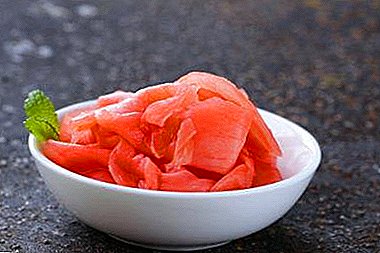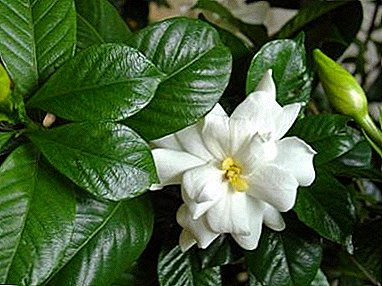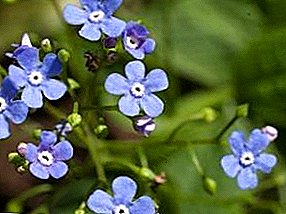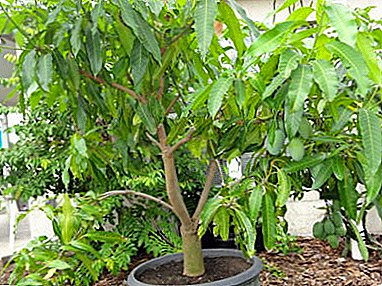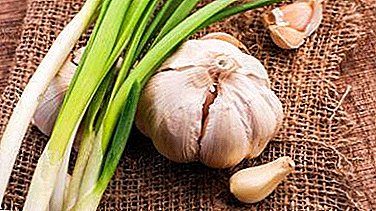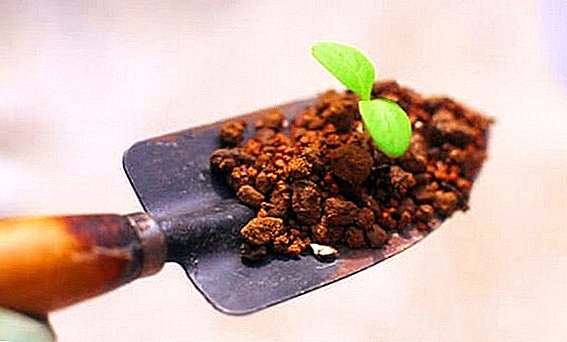 Disinfected substrate - a pledge of strong and healthy shoots of seedlings. So, the initial point of preparation for sowing seeds. Processing can be carried out by folk methods or apply chemical or biological preparations. To find out which technology is suitable for your site, consider the most common, low-cost and effective ways.
Disinfected substrate - a pledge of strong and healthy shoots of seedlings. So, the initial point of preparation for sowing seeds. Processing can be carried out by folk methods or apply chemical or biological preparations. To find out which technology is suitable for your site, consider the most common, low-cost and effective ways.
Why do you need it?
Tillage before planting seedlings is essential for seed germination and the formation of their potential. The viability of sprouts is directly affected by the ability of nutrient cations to penetrate into plant fibers.  If pathogenic microorganisms predominate in the soil, the grains caught in it will not be able to fully develop, since various nematodes, mycelium, mold and rot will prevent this from happening. Expect abundant fruiting or flowering from such an environment is not worth it.
If pathogenic microorganisms predominate in the soil, the grains caught in it will not be able to fully develop, since various nematodes, mycelium, mold and rot will prevent this from happening. Expect abundant fruiting or flowering from such an environment is not worth it.
Did you know? The number of microorganisms in a tablespoon of land is 2 times the population on planet Earth.In order to protect crops, many flower growers and vegetable growers use purchased soil mixtures. But this method requires material investments and does not guarantee the absence of pathogenic microbes.
The most reliable way, many farmers believe the annual change of land and disinfecting it at home.
Disinfection options
In the arsenal of gardeners there are many ways. Some owners prefer scalding, roasting or freezing the substrate, while others, not wanting to waste a lot of time, water it with disinfectants.
Let us analyze in more detail the more convenient it is to disinfect the ground before planting seedlings from improvised and purchased items.
Familiarize yourself with the rules for growing seedlings of tomatoes, peppers, eggplant, cabbage, leek, zucchini, strawberries.
Freezing
This method is considered the most simple and universal. Earthen ball for seedlings harvested in the fall. It is placed in a fabric bag and carried out in the winter to frost.
It is desirable that the soil stayed in conditions of low temperature for about a week, since some species of microorganisms will not die in a shorter period.  After freezing, the substrate is placed in heat for 7 days, waiting for the awakening of the larvae of pests and weed grains.
After freezing, the substrate is placed in heat for 7 days, waiting for the awakening of the larvae of pests and weed grains.
Then the bag is sent back to the cold. If the winter is warm and outside is less than -15 ° C, it is better to use the freezer and increase the time of frost.
Important! Freezing is contraindicated in biohumus substrates, since beneficial microorganisms and nutrients will die during the disinfection process.
Many for safety net doing a threefold freeze. But in this way it is almost impossible to get rid of late blight pathogens.
Calcination
The method consists in heating the substrate to a high temperature, which will allow it to clear itself of pathogens. Initially, the earth mixture is poured into the basin and poured a small amount of boiling water.
Then, when the contents in the container are slightly cooled, it is thoroughly mixed and placed on a baking sheet with a layer up to 5 cm. After the manipulations done, the soil can be sent to the oven.  It is important not to overdo it with the temperature, because too hot conditions contribute to nitrogen mineralization, as a result of which the soil loses nutrients, and some of them become inaccessible to plant fibers. Within 30 minutes, the earth needs to be roasted in the oven, setting the timer to 90 ° C.
It is important not to overdo it with the temperature, because too hot conditions contribute to nitrogen mineralization, as a result of which the soil loses nutrients, and some of them become inaccessible to plant fibers. Within 30 minutes, the earth needs to be roasted in the oven, setting the timer to 90 ° C.
Important! Regardless of the method of disinfection of the soil, at the end of the procedure it is necessary to fall asleep in clean, chlorine-rubbed containers.
Steaming
Such a technology for disinfecting land for seedlings takes a lot of time, but is more gentle, compared with radical calcination.
The soil is poured into a small metal sieve, which is placed in a fabric bag. You can do the opposite: pour the soil into the bag and put it on the grid. They put a bucket of water on the fire, bring it to a boil and set the grid with the ground on top. Ensure that the water does not evaporate completely. Steaming should be done for 1.5 hours. At the same time, strictly follow the recommendations of the organization and conduct of a water bath, do not over-soak the soil mixture on it. Otherwise, get not just a decontaminated lump, but completely devoid of all nutritious and useful.
This is what vacationers often complain about, who have resorted to this method of disinfection. Many, fearing a completely sterile and unsuitable for seedlings mixture, just before sowing the seeds injected into her bacterial dressing.
Biological agents
If for disinfection you decided to resort to the use of purchased means, first decide how and from what you plan to cultivate the land: fungicides, insecticides or potassium permanganate.
Did you know? To form 2 cm of fertile soil, you need a century.
Among the effective biological fungicides impeccable reputation - in "Fitosporina", "Alirina B", "Trichodermina", "Extrasola", "Planriz", "Gliokladina" and "Baikal EM-1".  In addition, these drugs contribute to the development of beneficial microflora and relieve fatigue from greenhouse and greenhouse soils, where the same plants are cultivated annually.
In addition, these drugs contribute to the development of beneficial microflora and relieve fatigue from greenhouse and greenhouse soils, where the same plants are cultivated annually.
After treatment with biologics, the pathogens disappear in the soil, the toxicity of iron and aluminum decreases, the amount of fluorine, nitrogen, potassium and magnesium increases.
Agrochemists isolated from the numerous list of effective drugs "Trichodermin". It contains fungal mycelium Trichoderma lignorum, which does not allow the development of cancer fungi and other pathogens.
The working solution is prepared at the rate of 1 g of substance per 1 l of water. Spraying is carried out, observing the measures of their own safety, exclusively from a spray bottle.  Some gardeners do without the development of agrochemical industry in the usual "grandfather's" ways. They consist in sprinkling cooked soil mixture with tincture of garlic, mustard or calendula.
Some gardeners do without the development of agrochemical industry in the usual "grandfather's" ways. They consist in sprinkling cooked soil mixture with tincture of garlic, mustard or calendula.
Important! Never disinfect with potassium permanganate sod-podzolic acidic soil, because the drug will contribute to further oxidation.
Chemical
It is recommended to resort to the use of potent chemicals only in extreme cases when agrotechnical and biological methods are powerless.
The most popular substance in this group is potassium permanganate, which is ideal for disinfecting sod-carbonate and chernozem soil.  The working solution is prepared from the calculation of 3 g of substance per bucket of water. They need to deeply water the cooked land. According to experts, this method is suitable for greenhouses and greenhouses only in combination with other toxic chemicals: Aktara, Thunder, Inta-Vir, and Iskra.
The working solution is prepared from the calculation of 3 g of substance per bucket of water. They need to deeply water the cooked land. According to experts, this method is suitable for greenhouses and greenhouses only in combination with other toxic chemicals: Aktara, Thunder, Inta-Vir, and Iskra.
It is believed that when processing the soil with potassium permanganate, pathogens die only in the surface layers, therefore, it is important to sprinkle copper sulphate (50 g / 10 l) 15 days before planting seedlings.
If you plan to grow crops that are sensitive to fusarium, gray rot and sclerotinia, it is necessary to disinfect the earth with "Iprodion". The drug is simply mixed with the substrate or scattered around the greenhouse.
Did you know? 27% of the world fund of black soil is located in Ukraine.
Bleaching powder acts radically, killing most pathogens. The lack of substance is that many plants react badly to the inherent chlorine. For disinfection of the greenhouse, agronomists advise to introduce formalin 2 weeks before planting the seedlings.
To prepare the working solution, it is necessary to dissolve 40 g of the substance in a glass of water, and then pour the mixture into a bucket of water. The substance is advised to use for crops that are vulnerable to blackleg.  After processing, be sure to cover the ground with foil, and after 3 days remove it and thoroughly dig the greenhouse. This is done to ensure that formalin evaporation comes out and does not destroy the plants.
After processing, be sure to cover the ground with foil, and after 3 days remove it and thoroughly dig the greenhouse. This is done to ensure that formalin evaporation comes out and does not destroy the plants.
For the disinfection of greenhouses also suitable chemical fungicide "TMTD", which can be used in dry form and in suspension.
Check out the list of drugs that will be useful to you for the care of the garden: “PhytoDoctor”, “Ecosil”, “Nemabakt”, “Shining-1”, “Nurell D”, “Oksihom”, “Actofit”, “Ordan”, "Fufanon".
How to change the acidity of the soil
Create favorable conditions for seedlings by adjusting the acidity of the soil. After all, it is no secret to anyone that the acidic environment promotes the reproduction of pathogens. Consider what are the ways to reduce and increase the pH of the reaction.
Boost
High pH values (from 7 to 8.5 units) indicate an alkaline substrate.  Therefore, if the plans - planting vegetable plants, which are mostly preferred to slightly acidic soils, you will need to take measures that increase acidity.
Therefore, if the plans - planting vegetable plants, which are mostly preferred to slightly acidic soils, you will need to take measures that increase acidity.
Did you know? In the process of weathering for 24 hours from the field can carry 5 cm of the fertile layer of the earth.
Popular is the method of using citric acid. It is enough to dissolve 2 tablespoons of the substance in a bucket of water. Alternatively, you can use oxalic acid or apple cider vinegar.
The soil is generously poured over the prepared solution. In cases of disinfection of the greenhouse per square meter of territory, 10 liters of liquid will be needed.  Some growers are advised to increase the acidity of the earth with sulfur and peat. Others for this purpose pour the battery electrolyte.
Some growers are advised to increase the acidity of the earth with sulfur and peat. Others for this purpose pour the battery electrolyte.
Downgrade
For cabbage, asparagus, cucumbers and other vegetation that grows comfortably in an alkaline environment, acidified soil mixture should be sprinkled with well-known fuzz or dolomite flour, old plaster. Even cement dust is suitable for this.  It is impossible to choose from all the proposed variations the most reliable and harmless for the nutrient components of the substrate.
It is impossible to choose from all the proposed variations the most reliable and harmless for the nutrient components of the substrate.
Experts advise first of all to resort to agrotechnical methods, but if they are powerless, take up biological and only in extreme cases chemical preparations.
The main thing is not only to eliminate harmful microbes and insects, but also not to destroy the nutrient microflora, to enrich it.



